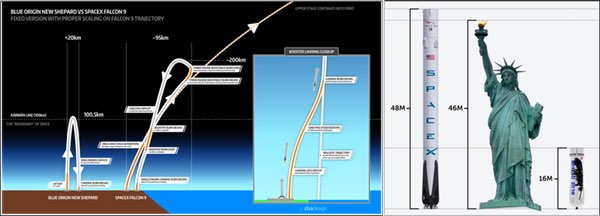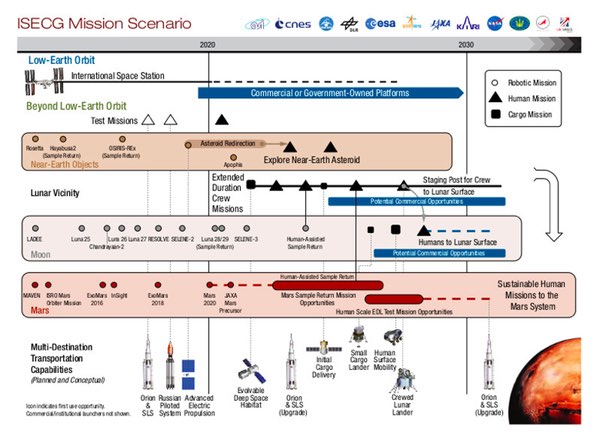Elon Musk and the SpaceX OdysseyCompleting the cycle of reusability and new challenges on the path to Mars colonizationby Tim Reyes
|
| But should that first stage be treated like the Golden Spike that connected a continent—as a museum piece? |
Few will disagree that the successful Falcon 9 first stage landing last month was a major step towards SpaceX’s goal of Mars colonization. The company had already made several prior attempts and, despite those earlier failures, we could still clearly imagine what success would look like.
During SpaceX’s six-month hiatus in launches after a June launch failure, Jeff Bezos’ Blue Origin lit another fire under Musk’s ambitions. Blue Origin raised the ante with its successful New Shepard landing, and, seemingly in response, SpaceX returned the Falcon 9 first stage all the way back to Cape Canaveral, from where it had launched just minutes earlier. But should that first stage be treated like the Golden Spike that connected a continent—as a museum piece?
While SpaceX struggled to recover a Falcon 9 first stage in 2015, other events created both lines of support and resistance for Musk’s Odyssey.
In a conversation with Neil DeGrasse Tyson on the “StarTalk” radio show in March 2015, Musk said, “I think we’ve got a decent shot of sending a person to Mars in about 11 or 12 years.” That is an arrival date of 2027; the same date, incidentally, set by Mars One colonizers. Any road to Mars is an orchestration of development milestones with necessary margins that, for Musk’s vision, must now fit into a mere eleven-year span.
The words of NASA administrator Charles Bolden, delivered in April 2015 to the House Science Committee, must have rung clearly in Musk’s ears. “No commercial company without the support of NASA and government is going to get to Mars,” Bolden said at the hearing.
With the exceptions of ESA’s Mars Express and India’s recent Mars orbiter, NASA alone has delivered more than 50 years of Martian discovery and has had a continued presence on and around Mars for 20 years, including more than 10 years roving the surface. NASA is now expressing the role of caretaker of Mars.
The challenges to the SpaceX Odyssey’s ultimate destiny thus became more immediate. There are clearly the technical hurdles, but now also social issues. How will SpaceX’s Odyssey mesh with NASA and international efforts? How will SpaceX cooperate to protect Mars from terrestrial contamination?
It is becoming clear that early Mars efforts by SpaceX will not go to building the proclaimed Mars Colonial Transporter (MCT) and delivering the first 100 colonists. That will certainly not be ready by 2027 or even 2030. Rather, an outpost of a half-dozen humans is more realistic; that’s what really is represented by Musk’s statement of sending a person by 2027. Those first humans on Mars could function as civil engineers, geologists, and hydrologists performing an assay of the Red Planet. They might begin landscaping and prepping landing sites, constructing habitats, and tweaking automated systems critical to maintain future colonists.
In 2015, another entity expressed opposition to sending humans to the surface of Mars: the Planetary Society. The society functions in one sense as a public trust for the solar system and aligns itself with the inclinations of JPL.
With Bill Nye, aka the “Science Guy,” at the helm, a team at the Planetary Society released a report on a plan to orbit humans around Mars first. This plan resists delivery of any human onto the surface lest we contaminate and immediately endanger any existing Martian life with our first footstep. “Germ-oozing” and “meat bags” were terms tossed by Planetary Society officials in arguing for landing on Phobos first.
So, in summary, NASA’s administrator says that no one goes without NASA, while a public trust calls for hands off until we know absolutely sure there is no fragile original life still residing somewhere on Mars.
| It is for the sake of humans on Mars that a Falcon 9 must be refitted with the used first stage and complete the reuse cycle. |
What is Musk to do regarding this resistance? First, he is likely ignore it. Musk is careful not to bite the hand—at least not too hard—that is feeding him: the US government. Most of SpaceX’s current revenue is from the government. NASA’s commercial crew program has provided the impetus to build the crewed version of its Dragon spacecraft. In addition, that program forced requirements and milestones on SpaceX to reach one of two next critical technological steps towards Mars. Without the NASA funds, motivation, and regimen instilled into SpaceX processes, SpaceX would have not yet reached their present milestones.
A separate issue from NASA concerns is SpaceX’s Falcon Heavy, whose inaugural launch is now more than three years behind schedule. Falcon Heavy is critical to increasing revenues and lowering costs. SpaceX will never reach Mars without a significant increase in revenue that can only be achieved by adding Falcon Heavy, as well as achieving reusability for both the Falcon 9 and Heavy. Moreover, the Falcon Heavy is necessary for lifting anything that could take a human to Mars.
 A launch in reverse, one for the record books, and the Falcon 9 first stage resting in the SpaceX hangar at Launch Complex 39A. (credit: SpaceX) |
So while the Falcon 9 leads the industry in cost and Falcon Heavy will lower the cost further, SpaceX still has work to do to achieve reusability. Musk must fly one again, then again and again, and prove their durability. Greater durability means lower costs to spaceflight. And here lies a subtle but critical resistance to achieving his ultimate goal. Simply said, it is sitting on his laurels: not flying the first returned stage.
If Elon Musk remains, as he has put it, “laser-focused” on sending humans to Mars, he does not have the time to spare a museum piece for historians and public viewing. Musk has said that the first stage landed last month will not fly again, instead being used for static fire tests on the ground before, eventually, heading for a museum.
While he is claiming this one is of historical importance—and it is— saving the stage is a half-baked idea. “I imagine we’ll have a whole fleet of booster rockets accumulating quite rapidly,” Musk said during a conference call with reporters after the landing last month. “It’ll take us a few years to iron that all out and make sure it all works well.” But stockpiling used stages doesn’t save or make money for anyone.
And now Jeff Bezos’ Blue Origin has just re-flown the New Shepard beyond the Kármán line (100 kilometers) and landed it safely. Bezos has completed the full cycle: he has reused a launch vehicle.
 A comparison of Blue Origin’s suborbital launch vehicle, New Shepard, and the Falcon 9. (credits: ZLSA Design (left), via Imgur) |
Yet, it is for the sake of humans on Mars that a Falcon 9 must be refitted with the used first stage and complete the reuse cycle. While NASA has instilled greater management, process control, and improvements from decades of lessons learned, Musk must raise the ante and risk losing a historical masterpiece.
| SpaceX must maintain as great an advantage on the competition as possible in order to dominate the launch industry for a decade, if not longer, if Musk is to realize his dreams of humans on Mars. |
Musk should risk losing the first stage but show what it means to inspire. That will double its value historically and, even if returned to Earth as shrapnel, SpaceX can still exhibit it alongside the eventual first core to close the cycle of reusability.
Musk must go for it. SpaceX must maintain as great an advantage on the competition as possible in order to dominate the launch industry for a decade, if not longer, if Musk is to realize his dreams of humans on Mars.
 Given all of the above organizations, this roadmap could be attempted but the timeline doesn’t fit. Bolden knows its constraints and sidetracks, and his successors will find out: excess costs of SLS and Orion, ISS operations, ARM and/or the Moon, and planetary protection. (credit: The Global Exploration Roadmap, International Space Exploration Coordination Group) |
Musk previously stated that a spacesuit would be revealed in 2015, as well as the first look at the design of the Mars Colonial Transporter, yet neither were revealed. But with all the daily chatter and intense talk inside SpaceX—plans and designs for Mars—could not the maiden flight of the most powerful American-made launch vehicle since the Saturn V include a payload hurled to Mars? Inspiration indeed.
Secondly, SpaceX remains in competition with what most SpaceX fans would call the dark side: large corporate aerospace companies like Boeing. Both are pushing to make initial flights to the ISS with their respective capsules in 2017. Boeing has decades of experience with integrating multiple subsystems into complete flight systems for human spaceflight. SpaceX is doing so for the first time but SpaceX has access, in various respects, to Boeing’s and NASA’s experience. It is a horse race, but one that SpaceX must do no worse than a close second.
The Crew Dragon technology and experience will be a huge step towards MCT by proving a life support system and a complete human spaceflight capability. In addition, its success will secure revenue and experience paid for by the US government, translatable to the settlement of Mars.
Yet, one must return to the comments from Nye, Bolden, and others that no one goes to Mars without NASA nor should anyone contaminate Mars biologically. The Planetary Society’s plan for going to Phobos first means that decades will pass before we touch boots on Mars. Forget 2030. Realistically, such plans will only see humans on Mars by close to 2050, and all are tied to the future funding and leadership of NASA.
Musk’s roadmap to Mars needs to show substance despite the ethical and social aspects of Mars colonization that are growing, and one way to do that is for SpaceX to achieve a technical milestone towards its Mars goals. Musk and others must also encourage the space industry to grow in order to fuel the SpaceX Odyssey towards Mars.
| Have it thrust a lean Dragon Cargo and upper stage around and Moon and back. Send a small payload to Mars with Falcon Heavy. |
At last month’s American Geophysical Union Fall Meeting, Musk stated, “I probably will not live to see it self-sustaining” when discussing a permanent human presence on Mars. Are the “space is hard” realities finally setting into the SpaceX plans for Mars? This year will determine if SpaceX Mars plans turn clinical and driven more by NASA requirements or, instead, become independently inspired.
Musk should fly the Falcon 9 first stage it landed last month to complete the cycle of reuse. Have it thrust a lean Dragon Cargo and upper stage around and Moon and back. Send a small payload to Mars with Falcon Heavy. With humans on Mars in 2027, do incredible science and groundwork for a future colony, and thus fulfill the reason for creating SpaceX, delivering far more than a small self-sustaining potted plant to the Red Planet.
